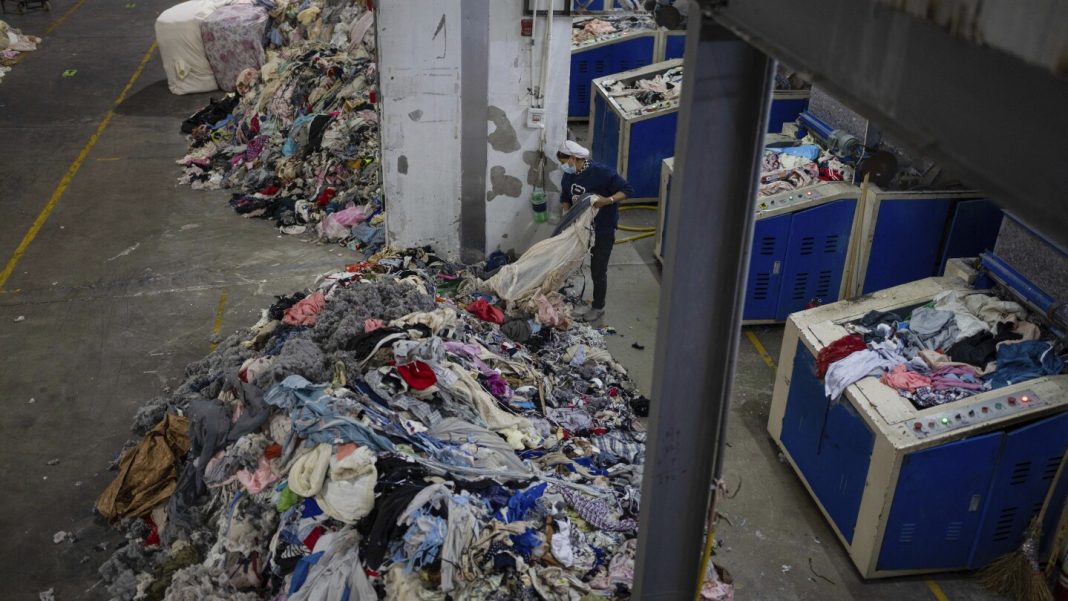WENZHOU, China (news agencies) — China is the world’s largest textile producer and consumer, throwing away 26 million tons of clothes each year, mostly made of unrecyclable synthetics.
A recycling factory in Zhejiang province on China’s east coast repurposes discarded cotton clothes to try to deal with the urgent waste problem. So, too, are young innovative designers in Shanghai, by remaking old garments into new ones or creating clothing out of waste items such as plastic bottles, fishing nets, flour sacks and even pineapple leaves.
But these efforts are dwarfed by giant fast-fashion brands churning out cheap synthetic garments for a consumer base spreading rapidly across the world. Experts believe real change is only possible through an elusive zero-waste workflow or Chinese government intervention.
Here are key takeaways from news agencies’s report:
At the Wenzhou Tiancheng Textile Company, mounds of discarded cotton clothing, loosely separated into dark and light colors, pile up on a workroom floor. Jacket sleeves, collars and brand labels protrude from the stacks as workers feed the garments into shredding machines.
It’s the first stage of a new life for the textiles at one of the largest cotton recycling plants in China.
But factories like this one are barely making a dent in a country whose clothing industry is dominated by “fast fashion” — cheap clothes made from synthetics, not cotton. Produced from petrochemicals that contribute to climate change, air and water pollution, synthetics account for 70% of domestic clothing sales in China.
Textile waste is an urgent global problem, with only 12% recycled worldwide, according to fashion sustainability nonprofit Ellen MacArthur Foundation. Even less — only 1% — are castoff clothes recycled into new garments. In China, only about 20% of textiles are recycled, according to the Chinese government — and almost all of that is cotton.
To achieve a game-changing impact, what fashion expert Shaway Yeh calls “circular sustainability” is needed among major Chinese clothing brands so waste is avoided entirely.
“You need to start it from recyclable fibers and then all these waste textiles will be put into use again,” she said.
Chinese cotton has a taint of its own, said Claudia Bennett of the nonprofit Human Rights Foundation. Much of it comes from forced labor in Xinjiang province by the country’s ethnic Uyghur minority.
“One-in-five cotton garments globally is linked to Uyghur forced labor,” Bennett said.
In May, the U.S. blocked imports from 26 Chinese cotton traders to avoid goods made with Uyghur forced labor. But because the supply chain is so sketchy, Uyghur cotton is used in garments produced in countries that don’t bear the “made-in-China” label, Bennett said.
“Many, many, many clothing brands are linked to Uyghur forced labor through the cotton,” she said. They “hide behind the lack of transparency in the supply chain.”
According to a report from independent fashion watchdog Remake assessing major clothing companies on their environmental, human rights and equitability practices, there’s little accountability among the most well-known brands.
The group gave Shein, whose online marketplace groups about 6,000 Chinese clothing factories under its label, just 6 out of a possible 150 points. Chinese fast-fashion e-commerce juggernaut Temu scored zero.
Also getting zero were U.S. label SKIMS, co-founded by Kim Kardashian, and low-price brand Fashion Nova. U.S. retailer Everlane was the highest scorer at 40 points, with only half for sustainability practices.
Cotton recycled from used clothing is banned from being used to make new garments inside China. This rule was initially aimed at stamping out fly-by-night Chinese operations recycling contaminated material.
But now it means the huge spools of tightly woven rope-like cotton yarn produced at the Wenzhou Tiancheng factory from used clothing can only be sold for export, mostly to Europe.
Making matters worse, many Chinese consumers are unwilling to buy used items, something the Wenzhou factory sales director, Kowen Tang, attributes to increasing household incomes.




